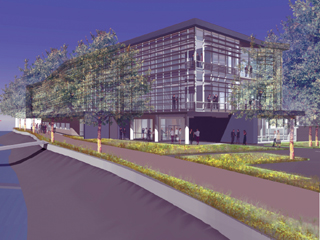
DJC.COM
February 14, 2008
Rising to the challenge of carbon neutrality
Perkins+Will, Seattle

Sturgeon
|
Just a few years ago the 2030 Challenge was known only by a small group of green building innovators.
Ed Mazria, a New Mexico architect, authored and established the 2030 Challenge in 2005. His goal is to achieve a dramatic reduction in greenhouse gas emissions by changing the amount of energy that buildings consume.
Once the challenge was adopted unanimously by the U.S. Conference of mayors in 2006 it rapidly gained momentum.
Numerous cities, states and organizations have adopted it, ranging from the city of Vancouver, British Columbia, and the state of Illinois to the American Institute of Architects and the California Energy Commission.
The challenge was significantly validated in December when President Bush signed its guidelines into law for all new and major renovations of federal buildings over $2.5 million.
So what is it exactly, and what do all these adoptions of the 2030 Challenge really mean? How do we adopt the 2030 Challenge in real terms and how do we implement its goals?
The requirements

Image courtesy of Perkins+Will The city of Tacoma’s Center for Urban Waters, a 56,000-square-foot office and laboratory building, will include a green roof, natural ventilation, daylit spaces, a rain garden and ground-source heat pumps. The project, set to begin construction later this year, is designed to meet 2030 Challenge energy-reduction goals. |
The 2030 Challenge is purely focused on the energy consumption of buildings.
Forget the comprehensive sustainable building approach of the U.S. Green Building Council’s LEED rating systems or the Living Building Challenge produced by the Cascadia Region Green Building Council.
The 2030 Challenge links global climate change to the energy that buildings consume. It uses the U.S. Department of Energy’s Commercial Buildings Energy Consumption Survey (CBECS) to benchmark its energy efficiency goals.
The national survey collects energy consumption information on existing U.S. buildings every four years.
The challenge
All new buildings, developments and major renovations shall be designed to meet a fossil fuel, greenhouse gas-emitting, energy consumption performance standard of 50 percent of the regional (or country) average for that building type.
At a minimum, an equal amount of existing building area shall be renovated annually to meet a fossil fuel, greenhouse gas-emitting, energy consumption performance standard of 50 percent of the regional (or country) average for that building type.
The fossil fuel reduction standard for all new buildings shall be increased to:
• 60 percent in 2010
• 70 percent in 2015
• 80 percent in 2020
• 90 percent in 2025
• Carbon-neutral in 2030 (using no fossil fuel greenhouse gas-emitting energy to operate).
These targets may be accomplished by implementing innovative sustainable design strategies, generating on-site renewable power and/or purchasing (20 percent maximum) renewable energy and/or certified renewable energy credits.
Is it possible?
Achieving the energy target of 50 percent is very possible in our region. Although it depends on the building type, typically compliance with the Seattle Energy Code can get us close.
The requirement in the 2030 Challenge is 50 percent less than CBECS, which is a recording of how much energy actual buildings use right now. It is not 50 percent better than ASHRAE 90.1, which is the benchmark used for the LEED rating system. Both the U.S. Green Building Council and ASHRAE (American Society of Heating, Refrigerating and Air-Conditioning Engineers) are reported to be working to align their performance targets with CBECS.
Terry Townsend, president of ASHRAE, says that by 2010 ASHRAE 90.1 will be 30 percent more stringent than in 2004. He estimates that will signify a 58 percent reduction compared with CBECS.
Achieving the two mandatory energy credits for LEED means that your project will be 14 percent better than ASHRAE 90.1. Generally speaking, ASHRAE 90.1 currently ranges from 15 percent to 30 percent better than CBECS. So, achieving the two energy credits required by LEED can get you to a range of 30 percent to 45 percent of the 2030 Challenge target for today.
However, achieving the higher targets for 2010 and beyond will require a shift in design approach. A “business as usual” approach will not get buildings to the 50 percent-or-beyond levels.
How to get there
Higher levels of energy efficiency can be achieved in four steps:
1. Design
The biggest and cheapest impact happens at the beginning of the project. The building should be located correctly on the site, use glazing wisely to limit heat gain and loss, utilize a high-performance envelope, shade the glazing where needed, and maximize daylighting and natural ventilation. User expectations of comfort also need to be addressed and compromises need to be made.
2. Efficiency
Once the energy demand has been reduced the next step is to design the lighting, HVAC and water systems to use the minimum amount of energy and water possible. By now you should get close to a 50 percent to 60 percent energy reduction, depending on the building type.
3. Technology
Now that the energy demand has been reduced as much as possible, consider alternative technologies to reduce the energy needs further, and to begin to generate energy for building needs.
Solar hot water, photovoltaics, wind power, geothermal energy and mechanical shading are all technologies to explore. This should get you to a 60 percent to 80 percent energy reduction, dependent on budget and location.
These technologies can be expensive, so project budgets need to be approached creatively. Trade the savings from the smaller HVAC system, which is a result of the energy-efficiency measures for these technologies.
4. Renewables
The 2030 Challenge is a reachable goal mostly due to the ability to rely on up to a 20 percent energy reduction from the purchase of renewable energy credits. Its targets and goals are also easy to understand.
For these reasons we are likely to see rapid adoption of the program in many more jurisdictions and organizations around the country in the near future. Look for a 2030 overlay coming from the U.S. Green Building Council and the American Institute of Architects’ “50 ways to get to 50 percent” toolkit available online at http://www.aia.org/fiftytofifty.
Amanda Sturgeon is a senior associate and the sustainable design leader for the Seattle office of Perkins+Will.
Other Stories:
- Charrettes evolve to help make projects lean and green
- Vancouver convention center goes for the gold
- Affordable green housing: a social, economic priority
- Reduce your footprint, starting with where you work
- Tapping a market by building green
- Let’s get pumped up about heat sharing
- New LEED standards help retailers go green
- What does sustainability mean in practice?
- When sustainability means putting people first
- Dead-end street to get an urban makeover
- Is LEED living up to its hype?
- New headquarters lets firm walk the green talk
- How one city is getting greener
Copyright ©2009 Seattle Daily Journal and DJC.COM.
Comments? Questions? Contact us.